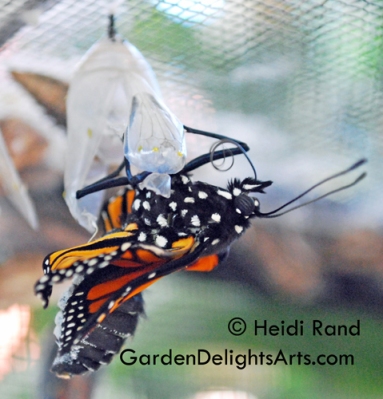George and I were jonesing for a monarch butterfly fix. This winter’s Big Storm uprooted the largest milkweed plant in our garden, and no monarchs have visited the smaller ones. Our butterfly-spotting treks to Albany Hill and Point Pinole Regional Shoreline, the over-wintering spots closest to us, were disappointing. We saw a few fluttering around Albany Hill, but nothing like past years’ large clusters. One paused on a branch at the top of the Hill long enough for me to photograph it.
And that’s why we both woke up yesterday morning with one thought: time to head for Ardenwood Historic Farm Park. Monarchs over-winter in Ardenwood’s eucalyptus grove from December to mid-February, and we’d heard through the butterfly grapevine (aka Facebook) that the numbers were good this year.
Ardenwood’s rangers are well-informed and eager to educate visitors about monarchs, from showing the butterfly’s life cycle to explaining the importance of growing milkweed and flowers, and not using pesticides. George quickly spotted a caterpillar munching on a milkweed leaf (Asclepias physocarpa) in their garden.

Then the ranger pointed out a chrysalis hidden under another leaf. An exciting first for us; we’ve seen so many monarch chrysalises in our butterfly “nursery”, but have never seen one in the wild!
 And finally! Hundreds of gorgeous orange monarchs fluttered above us in the bright blue sky.
And finally! Hundreds of gorgeous orange monarchs fluttered above us in the bright blue sky.

George and I, with the other awed visitors, lay on our backs to watch the dance.

Two flew near a red-tailed hawk making lazy circles.

As the sun slanted lower, the butterflies began to light on the eucalyptus branches.

We reluctantly left the monarchs to speed through the rest of the Park before it closed (stay tuned for further adventures). Want to see more of my monarch butterfly blog posts? Click these links:
Monarch Butterfly Mating Dance
A Monarch Butterfly Visits the Garden
Monarch Caterpillar to Chrysalis
First Monarch Caterpillar Emerges
Butterflies & Barbie at the Albany Library



















































